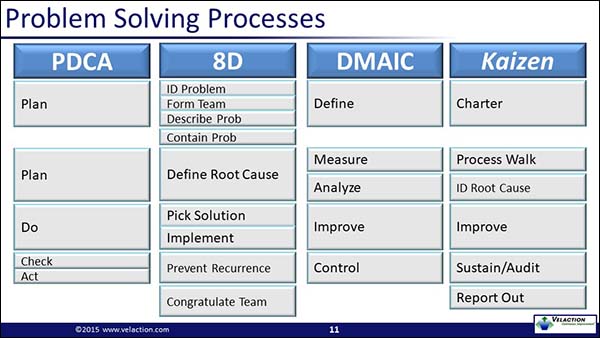8D Problem Solving / 8 Disciplines
The 8D problem solving methodology is similar to the DMAIC approach utilized by Six Sigma. Of note, 8D is a shortened form of the original name, ‘8 Disciplines’.

The 8D’s are:
- Identify the problem
- Use a team approach/form an 8D team
- Describe the problem
- Interim containment
- Define the root cause(s)
- Develop solution(s)
- Implement the solution(s)
- Prevent recurrence
- Congratulate the team

This 8D definition may raise the eyebrows of those familiar with the DMAIC problem solving methodology from Six Sigma. Many of these problem solving steps do, in fact, overlap with the DMAIC process. ‘Describe’ the problem (in 8D) aligns with ‘Define’ in the DMAIC methodology. ‘Define the root’ causes is similar to the ‘Analyze’ step, etc. Problem identification and congratulating the team in the 8D steps are not directly stated in the DMAIC methodology, but rather are implied.
The single biggest difference in the two methods seems to be the specific mention of ‘Interim Containment’ in the 8D methodology. This is the process of building a temporary stopgap into the process. While it is generally also done in conjunction with other problem-solving methods, formally mentioning it in 8D helps prevent skipping the step.
So, which is better DMAIC or 8D Problem Solving? Both are strong methods for solving continuous improvement problems. Both provide a consistent, structured approach, and both provide a common language so project status can be easily communicated throughout an organization.
My recommendation is to try both, and then choose the one that works best for you and your personal style. I would encourage you to establish (or follow, if it already exists) a corporate standard so the entire organization is using the same approach. That helps prevent confusion. And don’t be shy about altering the process steps to suit your needs.
The key point is to find a method that works for you, and then to use it.
![]()

Warnings about 8D Problem Solving:
- No matter how good a problem-solving methodology is, it will only work if it is used.
- Teams will not get good at problem-solving unless they are allowed to actually do it. During the learning process they will make mistakes. Managers need to be ready for this and use the errors as teaching points.
- The 8D problem solving process is one of many methodologies. Your company will work most effectively if you pick one and stick with it. It can be confusing to have different factions within your organization using different tools.

One of the most valuable skills you can develop is the ability to effectively solve problems. Because most people take a haphazard approach to coming up with solutions, the simple fact that you know about a step-by-step problem-solving methodology such as the 8 disciplines gives you a significant boost in the eyes of your leadership team.
The challenge most people have, though, with developing problem-solving skills is that the path is paved with mistakes. You don’t get good at solving problems without practice. And when you first start practicing, there will be a learning curve.
A good way to mitigate this is to find a mentor. He or she can help you avoid critical mistakes. A strong mentor shouldn’t insulate you from obstacles, though. Part of the learning process is figuring out how to deal with pitfalls. A good mentor knows how much leeway to give you while you attempt to overcome these challenges on your own.
Communication is also important. When you stretch yourself as you learn the 8D process, keep your boss in the loop. That way when you make mistakes, it will not be a big surprise for her. Good bosses recognize that teaching team members is an investment. A few mistakes now in a controlled environment is a small price to pay for turning you into a skilled problem solver for the future.

One of the best investments a leader can make in his or her team is developing problem-solving skills. Simply teaching the eight disciplines will make a marked improvement in your team’s ability to deal with issues quickly, efficiently, and effectively.
Bear in mind that there will be bumps along the way. Your team will make mistakes. How you deal with those mistakes will go a long way towards determining how committed they will be in taking on the challenge of learning to be effective problem solvers.
If they feel like they will be at risk when they take a chance, they will be tentative and reluctant to try. On the other hand, if they see that you will be reasonable and forgiving if they went through the problem-solving process, they will be more likely to internalize the methods.
The key is communication. You have to stay in touch with your subordinates who are working outside of their comfort zone. Ask a lot of questions and pay attention when your “Spider Sense” starts to tingle. For example, if a team member can’t clearly articulate what the problem is, pay attention to your gut. Don’t let them move on and start spending resources until they can convince you that they thoroughly understand the issue. Use a combination of scheduled meetings and ad hoc coordination as part of your communication plan. This keeps rookies from getting too far into the 8D process without you checking on them.
![]()
Try out each of the problem-solving methods on the same problem, at the same time. You might try having two teams both tackle the same problem in something of a competition of the methodologies.
This will let you get a true comparison of the two problem solving processes on an even footing. It is some extra up-front work but will help you make an informed decision about what works best in your company.
Click ‘Continue Reading’ to answer a poll question about using 8D Problem Solving.


0 Comments